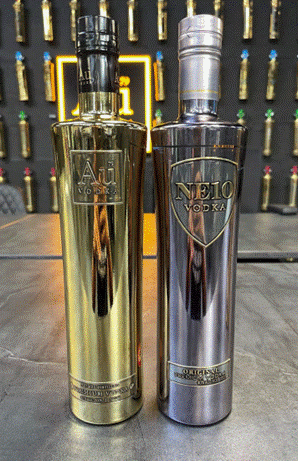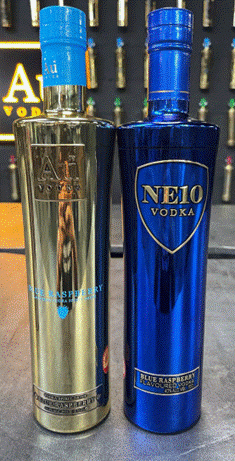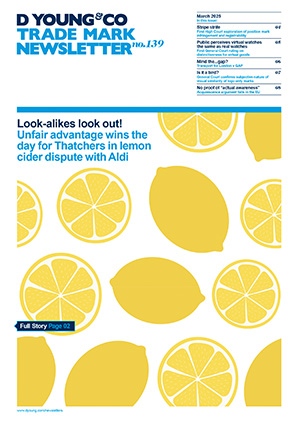Battle of the bottles: packaging dispute shows importance of early protection
On 16 September 2022, in a rare passing off claim based only on rights in the get-up and appearance of a bottle, as opposed to in any word or figurative marks, Mr Justice Mellor refused to grant Au Vodka an interim injunction against NE10 Vodka and Leon Hogan, NE10’s founding director. Instead, on application by NE10 Vodka, the court struck out part of Au Vodka’s claim against Mr Hogan and ordered an expedited trial.
Battle of the bottles: webinar
We have also published a short webinar covering this decision.
Read moreThe background
Au is a premium vodka brand which launched in 2015, but with notable success since 2019 when it launched a range of flavoured vodkas. Au Vodka’s annual revenues have now surpassed £40 million and the brand has received numerous celebrity endorsements.
Au’s vodka range (pictured below left) is sold in gold metallic bottles, with a label plate near the top of the bottle bearing the mark Au79, with a smaller label plate towards the base of the bottle displaying the flavour and other information. Each bottle has a different coloured cap depending on the flavour.

NE10 Vodka was launched in August 2022, at which time Mr Hogan, who is also the owner of four bars and restaurants in Swansea, was sole director/majority shareholder of the company. NE10 Vodka (pictured above right) is also sold in metallic bottles, though with a different coloured bottle (silver, blue or pink) depending on the flavour; notably, the range features no gold bottle. Within two weeks of NE10 Vodka’s launch, following some preliminary correspondence, passing off proceedings were issued by Au Vodka alleging that the get up of NE10 Vodka’s bottles was deceptively similar.
The applications
At the recent hearing, Au Vodka was applying for an interim injunction against the defendants to restrain the marketing and sale of NE10 Vodka. The defendants were also seeking strike out of the claim against Mr Hogan, which was brought against him for his own acts as well as being jointly and severally liable for NE10 Vodka’s acts.
The law
In determining whether to grant an interim injunction the “American Cyanamid” criteria are relevant. Although the purpose of these criteria is to avoid a mini-trial pending the actual trial, the judge noted that where the underlying cause of action is passing off, previous case law has shown that an assessment of the merits is unavoidable as there is an intrinsic link between the existence of a misrepresentation and the risk of causing irreparable harm to a claimant’s goodwill.
In American Cyanamid Co v Ethicom Ltd, the Court developed guidelines to establish whether an applicant’s case merited the granting of an interim injunction. These can be summarised as:
- Is there a serious question to be tried?
- Where does the balance of convenience lie? This question to include consideration of whether damages would be an adequate remedy for: (a) the claimant(s) if an interim injunction was not granted (if so, an interim injunction should not normally be granted assuming the defendant(s) could pay); and/or (b) the defendant(s) if an interim injunction was granted (if not, an interim injunction is unlikely to be granted).
- If other factors are finely balanced, the status quo should be maintained; and
- If the balance of convenience favours neither party the relative merits of the parties’ respective claims may be taken into account.
In relation to passing off, the classic trinity derived from Reckitt & Colman Ltd v Borden Inc (commonly referred to as the “Jif Lemon” case) is relevant: the claimant must establish goodwill, misrepresentation, and damage to succeed.
The decision
The judge held that the evidence submitted showed there was “no doubt” that Au Vodka had a reputation in the appearance of its products, or there was at least a serious issue to be tried on the point. However, the big question was which specific features this reputation was attributable to. He noted that the claimant’s pleaded get-up, which was in summary, an elongated metallic bottle of clean appearance with two labels akin to boilerplates at the top and bottom, was expressed very generally and was “influenced by the case they seek to maintain against the defendants”. He further noted that it was “striking” in the claimant’s evidence that most online/social media references to Au Vodka were by name (suggesting this was the most significant feature) and not for example “the one in the gold bottle”.
Again, when considering misrepresentation, while the judge noted the “extremely close” shape and dimensions of the rival bottles, he considered that the other similarities put forward by Au Vodka were “expressed at a level of abstraction which is divorced from what ordinary consumers perceive”. He highlighted the need to compare like for like and focused on the bottles containing Au Vodka’s most successful products, the flavoured vodkas. In this regard he remarked on the reduced similarity between the gold bottle/light blue cap of Au Vodka’s blue raspberry flavour (pictured below left) and NE10 Vodka’s dark blue bottle/dark blue cap (pictured below right) for the same flavour, when compared with the main comparison put forward by the claimant, between their plain gold bottle/black cap for their least popular unflavoured vodka and the plain silver bottle/silver cap of the defendant’s analogous product.

Au Vodka also submitted evidence of what it termed “instances of actual confusion”, of which there were seemingly six in the first few weeks of NE10 Vodka’s launch. However, when viewing these in context, the judge considered it was not evidence of actual deception. Instead those quoted were all merely wondering whether there was a connection between Au Vodka and NE10 Vodka, and were not deceived into believing there actually was one. The court gave a reminder that any misrepresentation must be a causative factor in a consumer’s decision to purchase: it is not proven if people merely wonder if there is a connection.
In dismissing Au Vodka’s application for an interim injunction the judge concluded:
- there was plainly a serious issue to be tried on passing off;
- the balance of convenience favoured NE10 Vodka because if Au Vodka won at trial damages and an injunction would largely compensate them, whereas, as NE10 Vodka had already launched, it was unlikely they could be adequately compensated if wrongly injuncted; and
- much will turn on the evidence available at trial.
Finally, parts of Au Vodka’s claim against Mr Hogan, insofar as they related to acts in his personal capacity, were struck out. An expedited two-day trial will now be listed for January 2023.
Comment
The key issues at trial will be to ascertain in exactly which aspects of its bottle’s get-up does Au Vodka’s goodwill reside, and whether NE10 Vodka actually deceives consumers. This will largely turn on evidence being acquired up until trial.
Beyond this, as packaging design is often a core feature of a brand’s reputation, goodwill, and ultimately value, this case serves as a timely reminder to:
- consider registered trade mark protection early (for example, for distinctive packaging shapes);
- remember that UK registered design protection is available for novel designs with individual character that have not been publicly disclosed for more than 12 months; and
- keep records of design processes and evidence of use which in time can be relied upon to evidence rights (for example, in unregistered designs) and/or claim acquired distinctiveness.
In short
This case provides a useful summary of the American Cyanamid criteria and the application of the law on passing off as applied in a rare “pure” get-up case. Evidence is critical in such cases, and the parties should ensure that what is being submitted actually evidences the points being asserted. If possible, seek registered trade mark and/or design protection early, as this can make enforcement easier (and often cheaper) and can even have a deterrent effect on copying.

